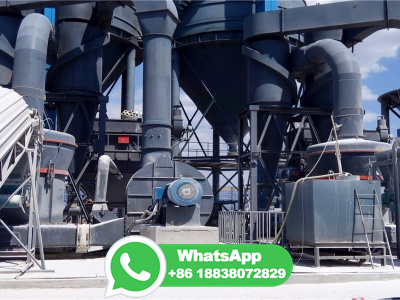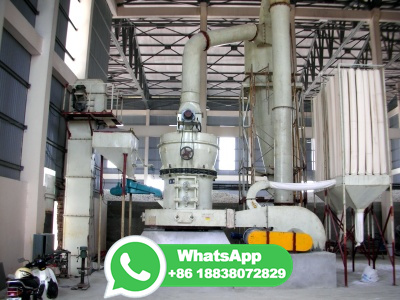
This paper is to integrate a new system for both COG and coal efficient utilizations, ... Local heat exchanger network optimization of industrial coaltoolefin process based on hot direct feed/discharge strategy. 2022, Applied Thermal Engineering ... Pyrolysis of coal by solid heat carrierexperimental study and kinetic modeling. Energy ...
WhatsApp: +86 18203695377
In an analysis of energy loss in the Taiwanese pulp and paper industry, Hong et al. (2011) estimated that in a typical manufacturing facility, equipment inefficiency accounted for an energy loss of 40%, boiler and electricity generation summed up for an energy loss of 32%, and distribution almost 28% energy loss.
WhatsApp: +86 18203695377
The national direction will phase out existing lowtomedium temperature coal boilers by 2037 and ban the installation of new lowtomedium temperature industrial coal heating devices, from 27 July this year. Under the new policy, resource consent will be needed for discharges of greenhouse gases from all fossil fuel heat devices generating 500 ...
WhatsApp: +86 18203695377
1 Global Efficiency Intelligence 2 David Gardiner Associates ... (Figure 1). Industrial process heating operations include drying, heat treating, curing and forming, calcining, smelting, and other operations. Five industries ... factor and average unit price of natural gas and coal used in our analysis are shown in Table 2.
WhatsApp: +86 18203695377
Industry represents 30% of primary energyrelated carbon dioxide (CO 2) emissions, or 1360 million metric tonnes of CO 2 (2020). The Industrial Decarbonization Roadmap focuses on five of the highest CO 2emitting industries where industrial decarbonization technologies can have the greatest impact across the nation: petroleum refining, chemicals, iron and steel, cement, and food and beverage.
WhatsApp: +86 18203695377
The Energy Information Administration lists the heat rate for different types of power plants, and the average operating efficiencies of thermal power plants in the in 2020 were: Natural gas: 44% efficient, meaning 56% of the energy in the gas was lost, with 44% of the energy turned into electricity. Coal: 32% efficient.
WhatsApp: +86 18203695377
Industrial heat can be decarbonised through the deployment of carbon capture, utilization and storage (CCUS). This can include, for instance, technologies to remove CO 2 emissions from flue gas before recycling the CO 2 in industrial processes, such as for methanol production, or storing it permanently. Finally, enduse efficiency, through the ...
WhatsApp: +86 18203695377
Work on industrial decarbonisation and process heat was established through the Process heat in New Zealand (PHiNZ) initiative in 2017, which was a response to one of the priority goals the renewable and efficient use of process heat in the The New Zealand Energy Efficiency and Conservation Strategy 2017 2022.
WhatsApp: +86 18203695377
Process heating and steam production consume large amounts of energy in industrial and commercial subsectors. There are substantial opportunities to improve energy efficiency, especially in older facilities. While process heating has previously relied on the combustion of fossil fuels, there are now many viable renewable alternatives.
WhatsApp: +86 18203695377
Coal oil is made by heating cannel coal with a controlled amount of oxygen, a process called pyrolysis. Coal oil was used primarily as fuel for streetlights and other illumination. The widespread use of kerosene reduced the use of coal oil in the 20th century. Coking coal is used in largescale industrial processes. The coal is coked, a process ...
WhatsApp: +86 18203695377
The roundtrip energy cycle efficiency of this system is dependent on the processes used to put the energy into the iron in the regeneration process. Highefficiency electrolysis of iron oxide can ...
WhatsApp: +86 18203695377
Industrial process heat is defined as thermal energy used directly in the preparation or treatment of materials used to produce manufactured goods. In developing countries, the industrial sector is responsible for 30 to 65 percent of total national energy consumption. Commercially available solar systems have the potential to provide a large ...
WhatsApp: +86 18203695377
• The industrial sector is on track to become the largest emitting sector by 2030; industrial heatrelated emissions from fossil fuel combustion are substantial. • Heat needs vary across industries; many clean solutions are needed. • Clean heat solutions exist for low and mediumtemperature applications, still there are challenges with
WhatsApp: +86 18203695377
Coal oil is made by heating cannel coal with a controlled amount of oxygen, a process called pyrolysis. Coal oil was used primarily as fuel for streetlights and other illumination. The widespread use of kerosene reduced the use of coal oil in the 20th century. Coking coal is used in largescale industrial processes. The coal is coked, a process ...
WhatsApp: +86 18203695377
Critically, CCUS is actionable today, providing additional GHG mitigation to industrial heat and process emissions as other options mature and become economically viable. Hydrogen combustion provided the readiest source of heat of all the options assessed, was the simplest to apply (including retrofit), and was the most tractable lifecycle basis.
WhatsApp: +86 18203695377
Many industries currently rely on coal and natural gasfired boilers for heat, ... Electricity is also likely to play a role in industrial process heat, ... Energy efficiency improvements can lead to the rebound effect, where the ability to do more with the same amount of energy leads to an increase in production and, thus, ...
WhatsApp: +86 18203695377
2 Process Heating generation and cogeneration, include essentially the same components, as shown in Figure 2, and often supply steam or hot water used for process heating. Over the last two decades, industry has made significant improvements in process heating efficiency, which has resulted in a reduction of energy per unit of production.
WhatsApp: +86 18203695377
Moreover, through recovering waste heat from industrial process, largescale heat pumps could achieve a better performance. As shown in Fig. 3, there are two validated cases based on waste heat recovery for district heating adopting absorption heat pump and compression heating 3 a shows the absorption heat pump absorbing heat from power station's waste heat (Heat source: ∼35 ...
WhatsApp: +86 18203695377
Process heat is the most significant source of energy use and greenhouse gas emissions in the industrial sector, accounting for about 50% of all onsite energy use and 30% of greenhouse gas emissions, according to the 2018 Manufacturing Energy and Carbon Footprint analysis. Process heating systems are emissionintensive because fossil fuel ...
WhatsApp: +86 18203695377
Metallurgical and ceramic processes require high heat. For example, % aluminum melts at 1,214°F (657 °C), and carbon steel begins melting at 1,425°F (734°C). Ceramics require kiln temperatures from 2,124°F to 2,264°F (1,162°C to 1,240°C). Every industry requires process heating solutions.
WhatsApp: +86 18203695377
The required temperature of the process varies widely, with about half the industrial process heat having operating temperatures above 400 °C (752 °F). These highertemperature processes can generally only be supplied by dedicated supplies like natural gas or coal, although preheating from other sources is also common in order to reduce fuel ...
WhatsApp: +86 18203695377
Chemical looping gasification (CLG) is an innovative clean coal conversion technology with industrial application prospects. The technical reliability of coal CLG (CCLG) in an autothermal state remains to be investigated. ... The thermodynamic irreversibility mainly originated from the redox process. The system heat efficiency was %, the ...
WhatsApp: +86 18203695377
The third type is the steambased process heating system. This type of heating system uses the application of steam for heating. It is similar to a fuelbased system. The application of steam can be applied directly or indirectly. This type of heating system is very significant for lower temperature industrial process heating,, below 400 °C.
WhatsApp: +86 18203695377
• Coal • ByProduct Fuel Heat Generation Energy Source Heat Containment ... Some typical opportunities for increasing the efficiency of process heating systems are shown in the table. ... sheet describes how manufacturing plants can save energy and money by making energy efficiency improvements to their industrial process heating systems ...
WhatsApp: +86 18203695377
Abstract. Excess heat from industrial processes can be used for carbon capture and storage (CCS) as well as providing heat to a district heating network, leading to increased energy efficiency and reduction of onsite and/or offsite CO 2 emissions. In this work, both options are assessed with respect to economic performance and potential ...
WhatsApp: +86 18203695377
Process heat is the energy used as heat mainly by the industrial and commercial sectors for industrial processes, manufacturing, and warming spaces. This is often in the form of steam, hot water or hot gases. Around half of New Zealand's process heat demand is met by burning coal or natural What is process heat? Process Heat Overview
WhatsApp: +86 18203695377
Industrial manufacturing approaches are associated with processing materials that consume a significant amount of thermal energy, termed as industrial process heat. Industrial sectors consume a substantial amount of energy for process heating over a wide range of temperatures (up to 400 °C) from agriculture, HVAC to power plants. However, the intensive industrial application of fossil fuels ...
WhatsApp: +86 18203695377
article{osti_, title = {Generation and Use of Thermal Energy in the Industrial Sector and Opportunities to Reduce its Carbon Emissions}, author = {McMillan, Colin A. and Boardman, Richard and McKellar, Michael and Sabharwall, Piyush and Ruth, Mark and BraggSitton, Shannon}, abstractNote = {The industrial sector was the thirdlargest source of direct greenhouse gas (GHG ...
WhatsApp: +86 18203695377
A large portion of industrial sector emissions, estimated at about Gt of CO 2, 8 or about 21% of global CO 2 emissions in 2016, 9 result from a single process: the generation of over 100 EJ th of heat (we use the colloquial shorthand "heat" for the thermodynamic term "thermal energy" ). 5 As shown in Figure 1, the combustion of three fuels—coal, natural gas, and oil—generate ...
WhatsApp: +86 18203695377
The market participants engaged included the following large industrial process heat users, ecosystem players such as network operators, fuel suppliers, consultants and longterm capital providers: 1 Ministry of Business, Innovation and Employment and Energy Efficiency and Conservation Authority, 'Process heat
WhatsApp: +86 18203695377
The paper presents experimental and numerical investigation of pulverized coal combustion process analysis and optimization. The research was conducted on the frontfired pulverized coal boiler with dedicated lowNOx furnace installation. In order to find optimal boiler operating conditions the acoustic gas temperature measurement system and mass flow rate of pulverized coal measurement system ...
WhatsApp: +86 18203695377
The optimal heat exchange plan allowed the system to operate without an external heat source. The thermodynamic irreversibility mainly originated from the redox process. The system heat efficiency was %, the product exergy efficiency was %, the total exergy efficiency was %, and the total exergy destruction rate was %.
WhatsApp: +86 18203695377